Wellington Phoenix are one of the most gripping sides in the Women’s A-League for the 2023/24 campaign. Not least for their new manager, Paul Temple, who was promoted from within, having worked previously with the men’s reserve side and as academy director. He was the youngest ever head coach at a World Cup when he led the New Zealand U17 side to a World Cup in 2008 at just 26 years old.
15 years later, he has taken on the head coach role at Wellington Phoenix. Before his arrival, they had finished the season in last position, winning just three games all season. However, this season, they have already won three of their opening five games, and a bright future is on the horizon.
In this tactical analysis, we look at how Temple has constructed such a bright start to the season while analysing critical tactical ideas, players and statistics that make his side so enjoyable.
In possession
One of the most noteworthy changes from this season to last is Wellington’s ability to retain possession. Possession has risen from 49.3% to 52.8% this season. The number of passes completed per 90 has also increased from 275.9 to 326.0 — a significant rise which puts them second in the A-League in terms of passes completed per game, only behind Melbourne City, who have a staggering 477.5 passes completed per 90 so far this term.
However, this possession is not just passive; Wellington look to work the opposition shape in two primary ways: they stretch the field, use wide players, and then move the ball to the space; however, most importantly, they will also look to play penetrating passes through the opposition’s shape.
Young midfielder Macey Fraser is the best at receiving these passes; she regularly receives the ball between the lines and progress attacks from these dangerous areas. Both these approaches work nicely together as the opposition is stretched and gaps open up centrally, which is when Wellington can hit you through the middle.
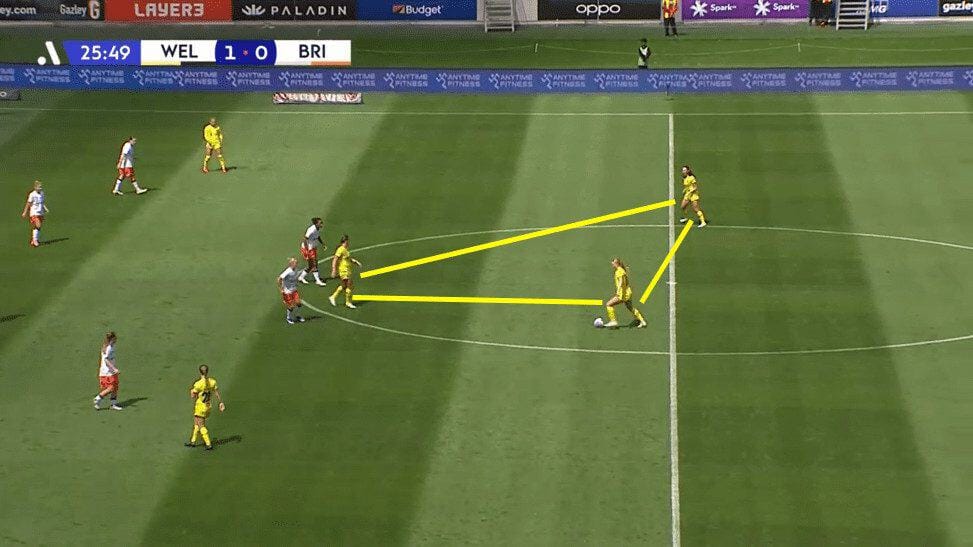
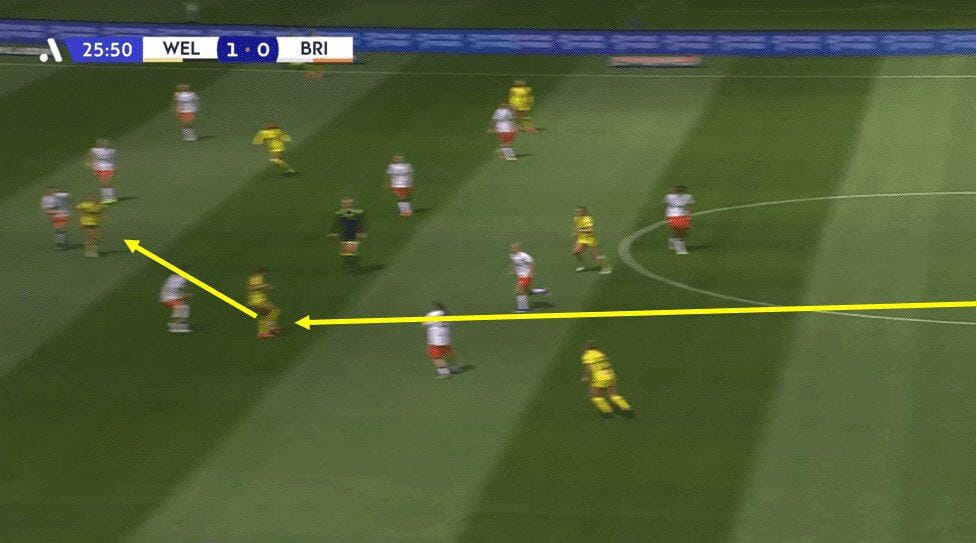
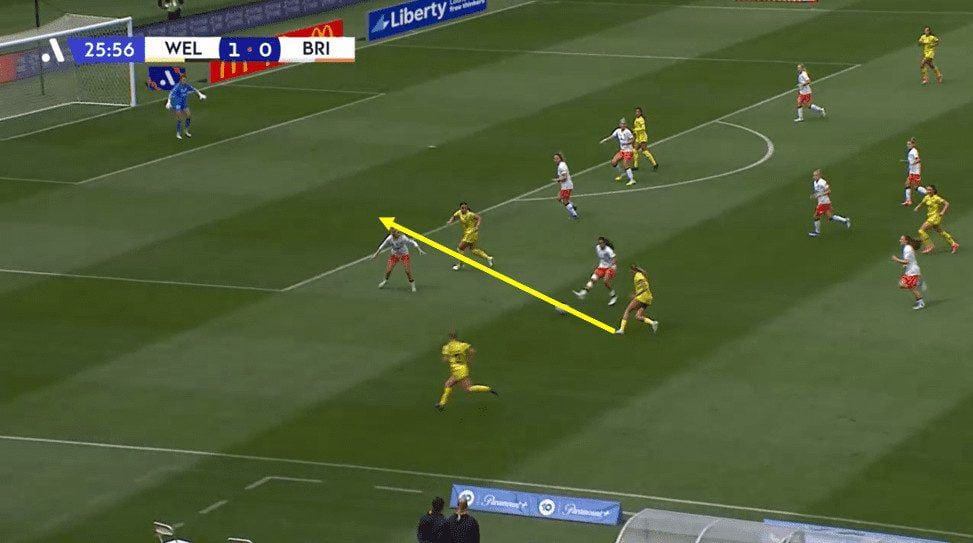
Above is an exceptional passage of play by Wellington where they win the ball back with the defence following a long ball. They then retain the ball for just over a minute.
First, what they do is play the ball between the centre-backs and pivot midfielder, in this case, Kate Taylor, in front of the opposition shape, waiting for space to appear. They work the ball to the right flank before moving it back across again.
Then, Marissa van der Meer plays a penetrating pass to Fraser, who receives between the lines and flicks the ball onto forward Mariana Speckmaier. She can pick up the ball and play this through pass to the on-running Michaela Foster. We then see Foster get a shot off.
After this comes their play in the final third, which enables them to create chances. They try to take advantage of wide situations, mainly through having dynamic runners creating this fluid style of play.
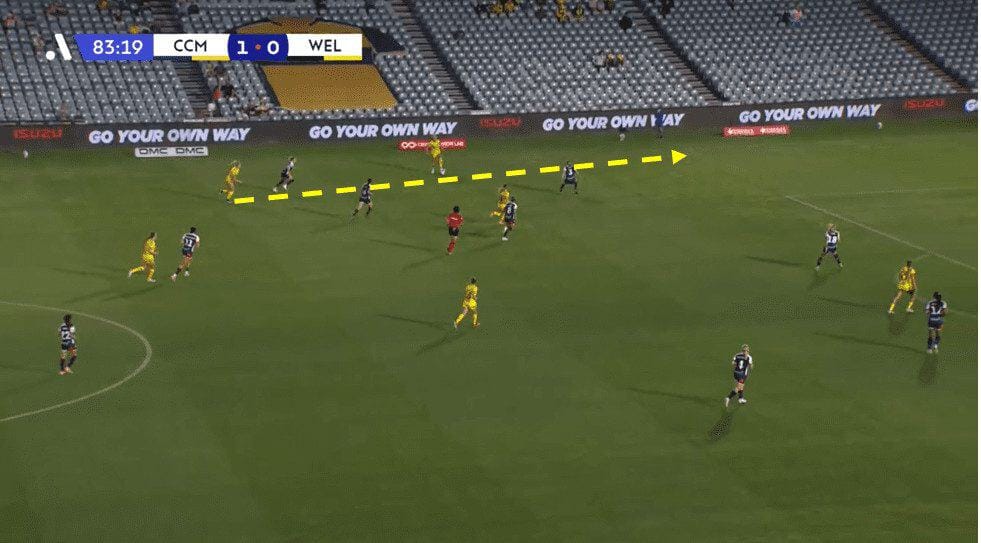
In the above example, they have created a wide triangle with the left winger on the ball. You then get the full-back making an underlapping run. This draws the defender’s attention, allowing her to cut in and play a deep cross into the box.
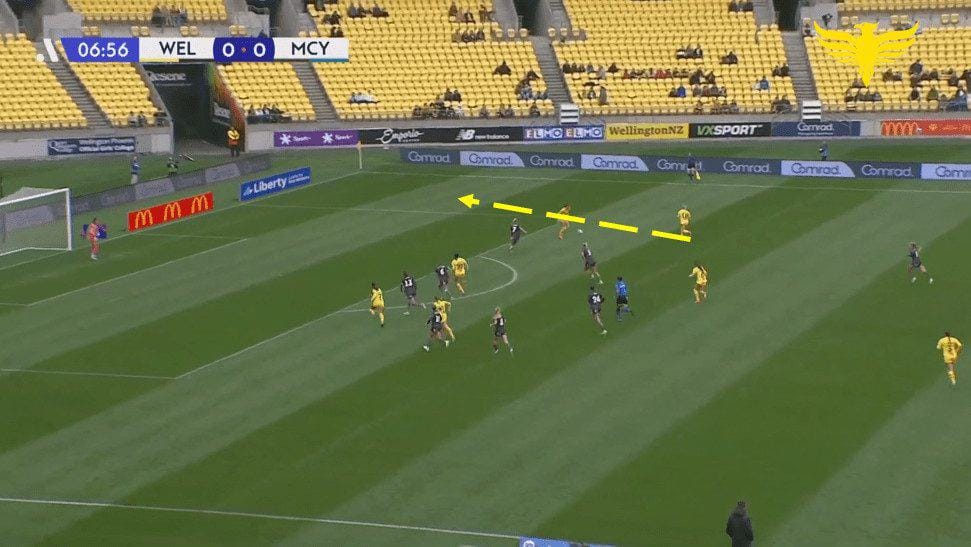
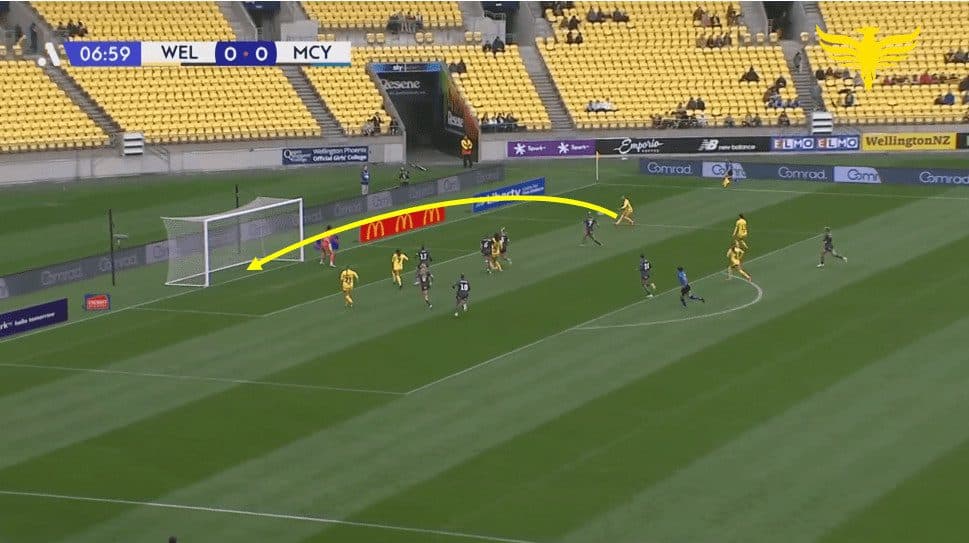
In the above example, you have the Melbourne City left-back isolated in a 2v1 situation with the winger, Hope Breslin, receiving from Fraser, having just broken through the Melbourne shape. Brelin is then overlapped by right-back Hailey Davidson, who can play a dangerous ball across the box aimed at the three players in the box, again a recurring theme for Paul Temple’s side. However, on this occasion, the ball goes over the top of everybody, and the chance peters out.
Out of possession
With such a young and hungry squad at his disposal, Wellington would also be aggressive and try to press high up the field. However, unlike some sides who might be relentless in their press. Wellington is opportunistic and time their press with significant effect.
The primary trigger for them is the ball moving backwards. This approach has proved very effective throughout the year, enabling them to be second in the league regarding ball recoveries with 106.2 per 90 and Brisbane lead with 107.5.
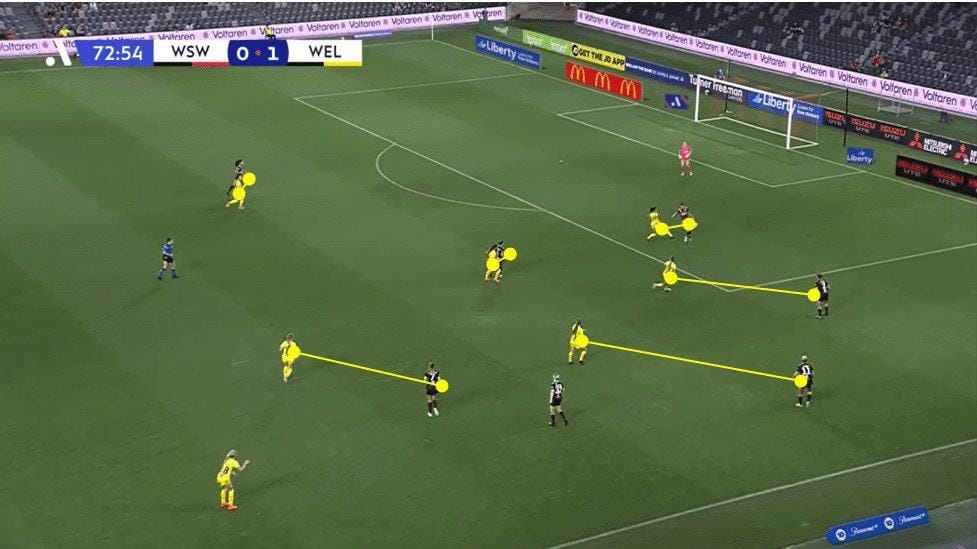
In the above situation, the ball has just been played back to the centre-back from a throw-in. Wellington senses their opportunity here and presses in numbers with six Phoenix players in the final third, all tightly marking or putting pressure on a Western Sydney player. This enables them to win the ball back just outside the box.
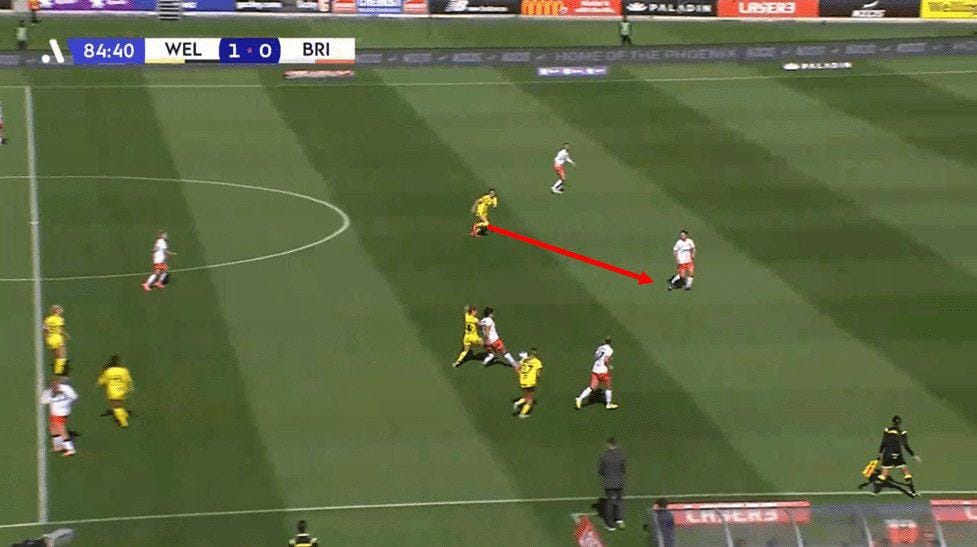
In this example, the Brisbane midfielder turns back to play to her defence. Wellington is instantly on this, and Annalie Longo gets onto her and puts pressure on the pass. At the same time, Hope Breslin goes to where the balls will be played and can capitalise on a poor Brisbane pass and win the ball back, leading to a Longo goal following a good run forward.
However, despite them having some success here when the ball was nearer the middle of the field, gaps in the Wellington shape appeared. With Phoenix deploying a 1-4-1-4-1 shape, they left the defensive midfielder Taylor isolated, and when the Phoenix press was broken, they could be left thin for numbers.
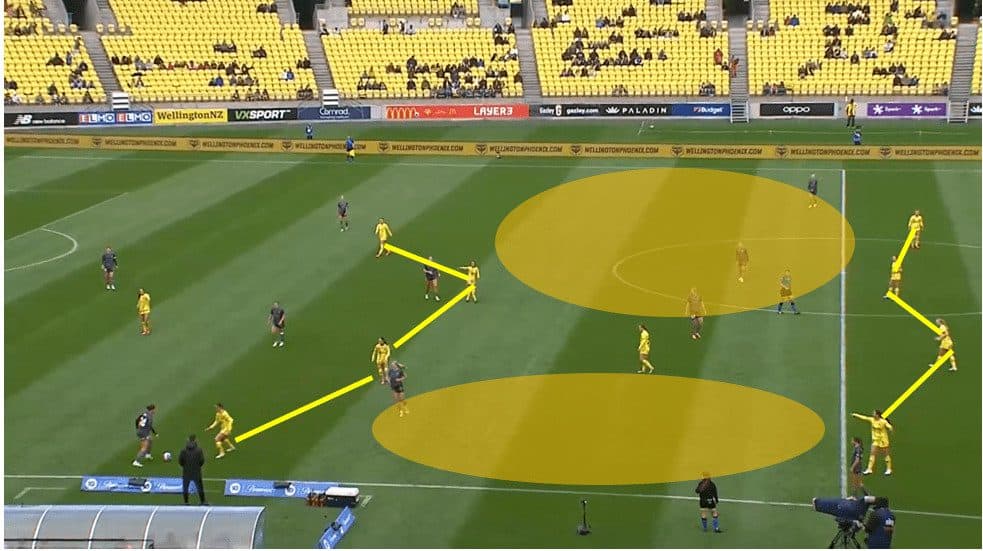
The above example shows how the 1-4-1-4-1 shape leaves Taylor isolated in front of that backline. Taylor was forced to cover three players in space between the lines who could easily beat her by executing a 3v1.
Although, as we have already discussed, Wellington isn’t often forced onto the back foot to defend deep.
However, luckily for us, they played the possession-dominant Melbourne City on the opening weekend; in this game, Melbourne had 61.77% of the possession. In this game, Wellington looked to sit deep and have two defensive lines where they tried to track the Melbourne City midfield rotations.
While Taylor still screened the defensive line, she could place herself where she was best needed. Now, this worked for the majority of the game, only falling in the last 20 minutes following a rebounded shot that fell to a City player.
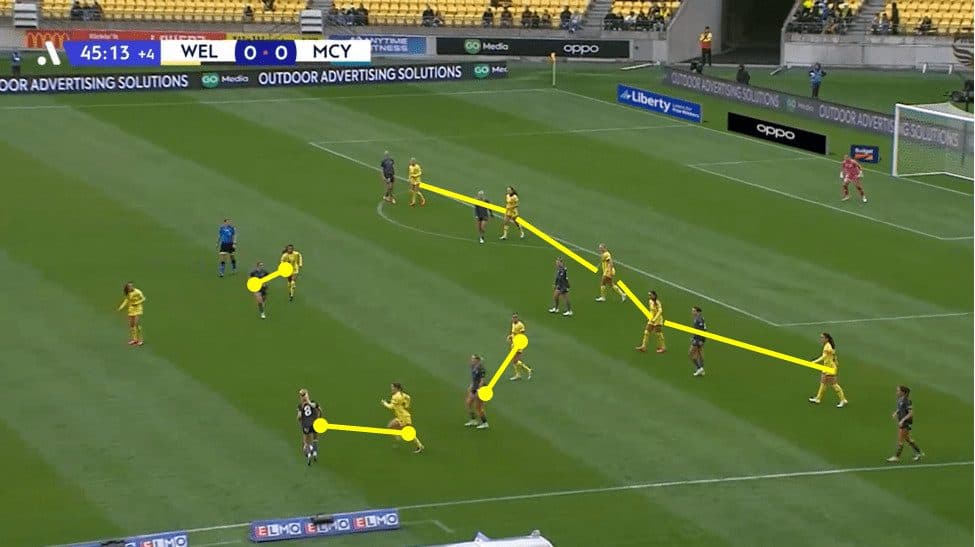
Above, you can see the defensive line with Taylor screening just in front of it. In this case, she is playing even deeper, trying to mark a forward out of the game as City looked to attack with a front five. In midfield, you can see how Phoenix is trying to track the City players and prevent them from having any time on the ball.
Transition
In defence-attack transition, although often in control of the ball and territory, on several occasions, Phoenix have demonstrated their ability to break with speed, particularly down the wide channels and progress the ball up the field quickly.
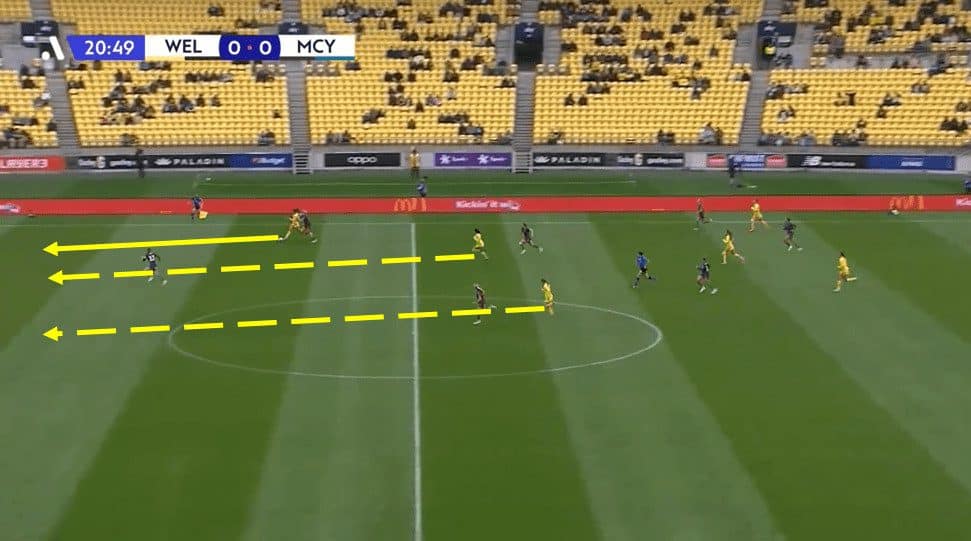
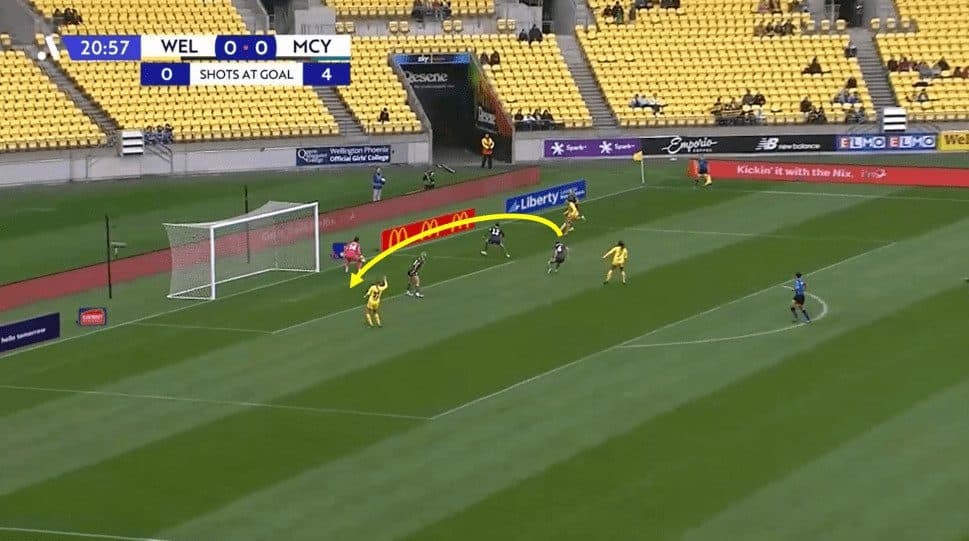
In this above example, Emma Main drives forward on the ball down the right flank. She is able to carry the ball some 40m and then beats the left back 1v1 before playing a ball into the back post towards Manaia Elliot. She also has the pullback option to Chloe Knott. However, this is well covered by the City defender.
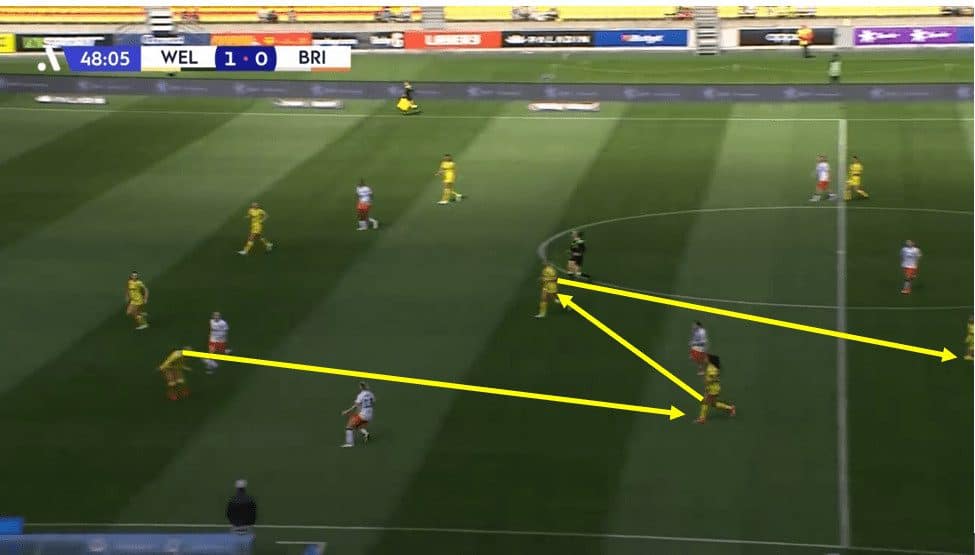
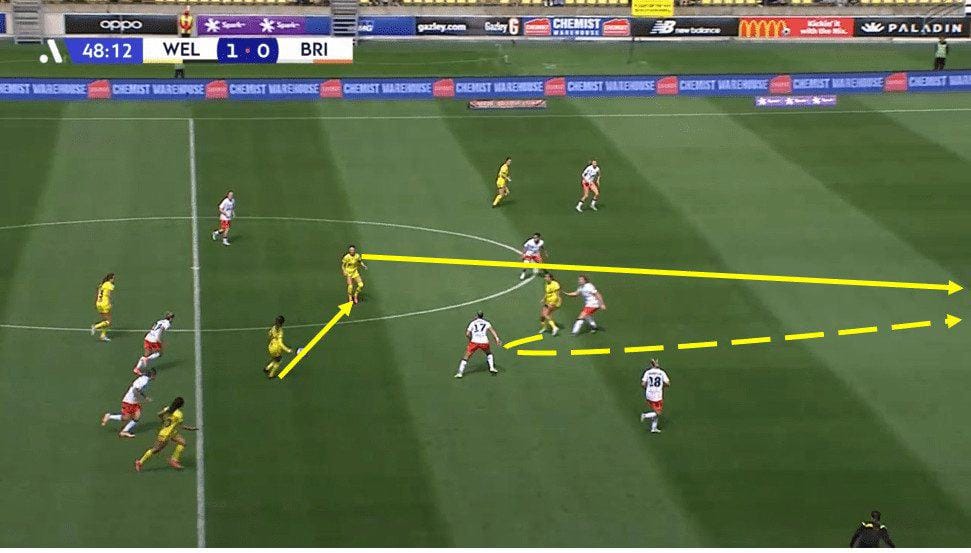
In this above example, Wellington takes a more patient approach. The ball was won back by right-back Hailey Davidson, who headed it down to Emma Main before some tidy combination play allowed them to progress into midfielder Knott.
Knott then takes advantage of a poor defensive angle by the Brisbane midfielder and plays the ball into midfielder Fraser, who plays Speckmaier through on goal. The key from this is how Wellington’s first point of call is to bring the ball down and then to try and play forwards after that.
In attack-defence transition, Wellington can struggle. As in possession, they operate a high defensive line. With Taylor screening that backline, it can leave them vulnerable as they have only three or four players back in position to defend.
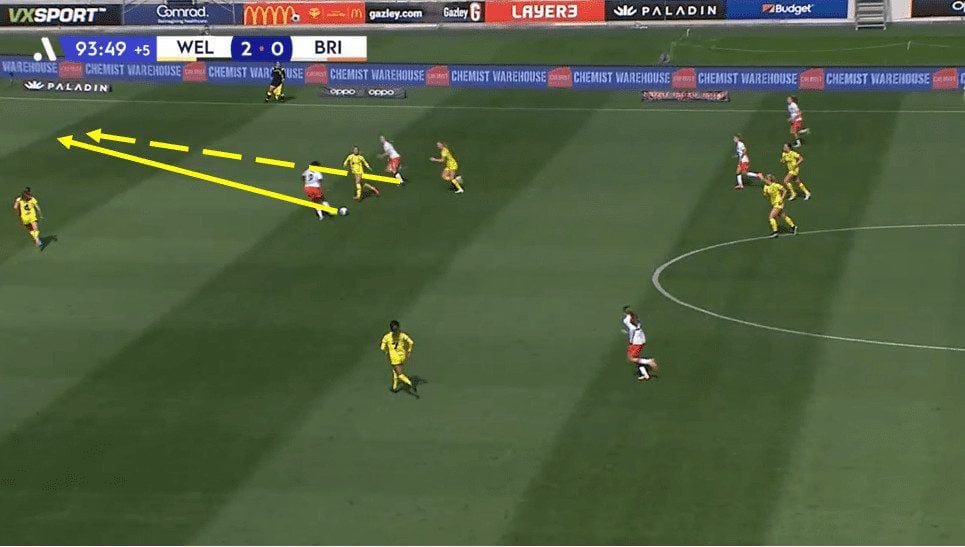
Having just given the ball away from the defensive line, they only have one player behind the Brisbane number nine. This means that Brisbane has lots of options for which spaces to attack. As such, they can progress into a dangerous area, which eventually results in a late goal for Brisbane in this game.
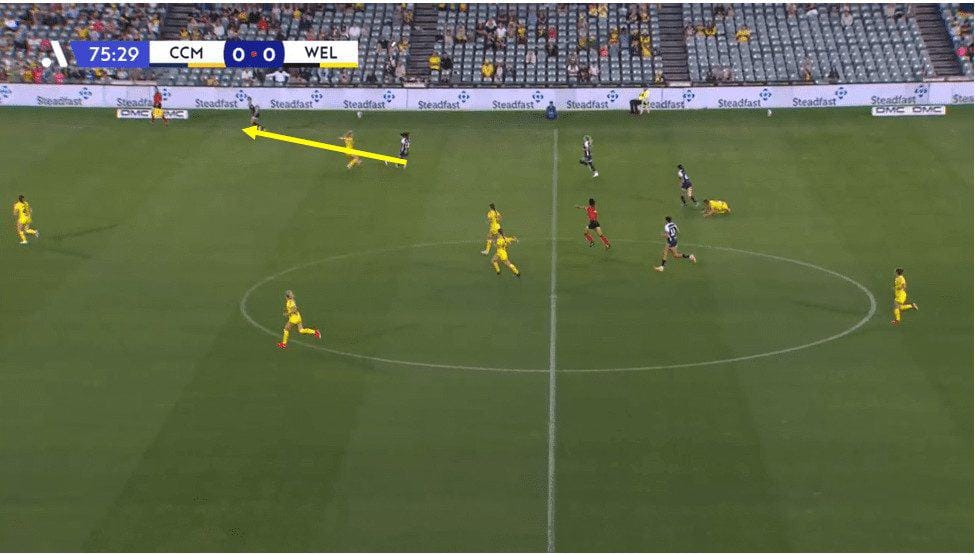
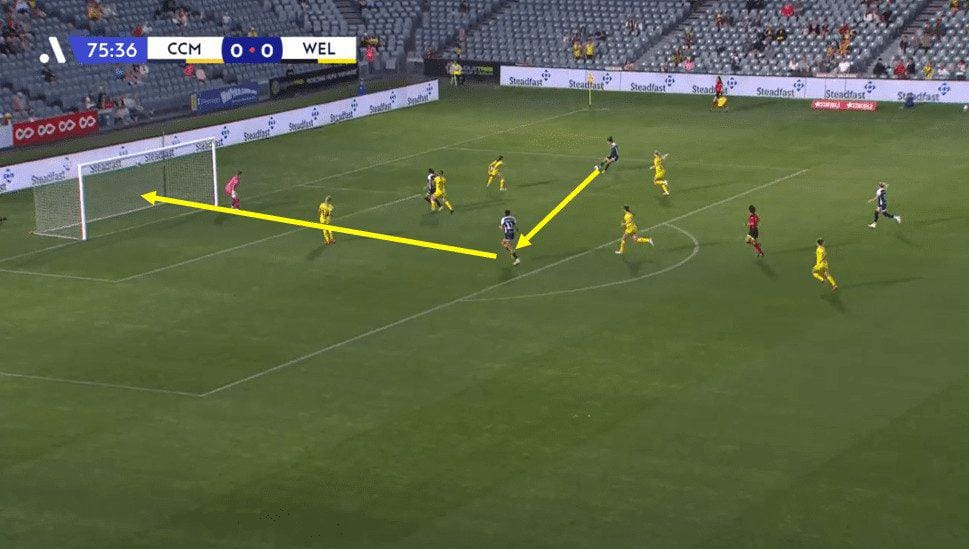
Having lost the ball in their high possession shape, Wellington is left depleted in numbers at the back, and Central Coast are able to get the ball forward quickly. They then execute a 2v1 against an isolated central defender. The ball gets out wide, and Central Coast can pick out Annalise Rasmussen, as highlighted, before the Phoenix midfield can get back in time to have an effect on the play, and Central Coast can score the only goal in the game to inflict Wellington to a 1-0 loss.
Strengths
We have already illustrated how Temple’s side can be effective in playing an attractive style of possession-based football. This approach has enabled them to take more control of games than before. A significant reason for this being so effective is the ability of defensive players, particularly central defenders van de Meer and Barry. Still, midfielder Macey Fraser and her ability to find pockets to receive the ball between the lines is the most integral part of this. When she has the ball, she has remarkable technical qualities, which allow her to create chances for herself or her teammates, many examples of which have been demonstrated above.
Another major strength we haven’t already covered is Wellington’s ability to score from set pieces this season, having already scored three set-piece goals in the opening five games. Here are a few examples of why they have had success in this area.

Michaela Foster takes a wide free-kick into the box. Wellington has several well-timed boxes into the box, nothing too complicated; everyone is just running straight forward, but it’s well-timed, and Speckmaier can reach the ball with momentum and head the ball in for the game’s opening goal.

In the above example, Foster is going to play an inswinging left-footed cross into the 6-yard area. Wellington is set up with five players inside the six-yard area in an attempt to congest this area and create uncertainty in the Western United defence. They get their reward with the ball, resulting in an own goal. This same method got them the game’s opening goal in the first half, so it was a focus of their game plan.
Weaknesses
The weaknesses within this side are how exposed they can leave themselves at the back because they are so positive going forward. As such, they leave themselves the potential of being hit on the counter, and teams may feel that they can just sit back in a low block and try to see the game out and wait for their opportunity to come.
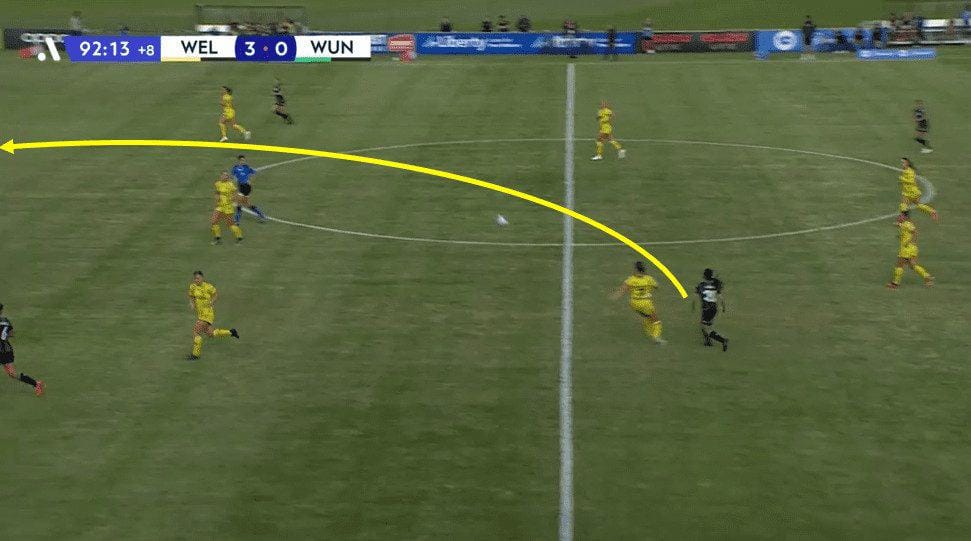
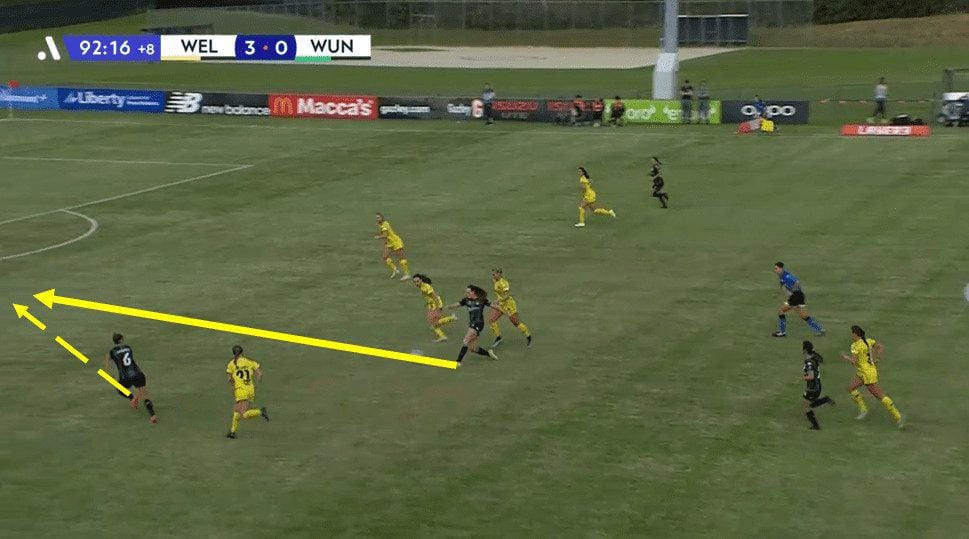
In the above example, Western United bypassed the Wellington midfield by simply playing a more direct ball over the top of it toward their striker. Their striker is able to bring the ball down and has room to operate because of Wellington’s defence-midfield line disconnect. The striker can then play her teammate through on goal as Elliot fails to pick up this forward run, and Western United can score their only goal of the game.
Conclusion
Above, you can see what Paul Temple has been able to cultivate in only a short period with this Wellington Phoenix squad. The aspect that interests us the most is that the squad is still so young, with it being the youngest in the A-League and many of the stars in the side being 21 or younger. This team has so much potential to grow and be a consistent contender in this league — a stark contrast to last year’s campaign, where they finished rock bottom in the division.






Comments